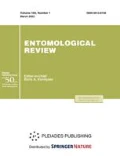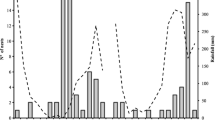Abstract
The structure and composition of Osmia dimidiata nests were studied based on the material of 133 nests obtained from trap-nests in five localities of the Crimea. The nests contained from 1 to 9 cells (on average, 2.2), separated with partitions made of masticated leaves. Most of the cells had a massive hemispherical bottom and a thin flat cover. The final plug had a structure similar to the cell bottom. The cells occurred singly in the nest cavity or were arranged in rows of 2 or 3 cells separated by galleries. The diameter of the occupied cavities was positively correlated with the fraction of the females in the progeny and with the mass of the cocoons, but negatively correlated with the cell length. The cells with females were 1.5 times as long as those with males. The cocoons with females were twice as heavy as those with males. The peculiar characters of the nest structure of O. dimidiata may mean that the typical nesting substrates of this species are abandoned cells of other bee and wasp species. The characteristic mechanism of estimating the mass of the pollen loaf stored in the cells and determining the brood sex ratio has evolved in the O. dimidiata due to its tenantry. This mechanism is based on two constants: the sex-linked cell length and the fixed distance between the pollen loaf and the cell cover. When choosing the nesting cavities, the female prefers broader and longer tubes for cells with females and narrower and shorter ones for cells with males. The overall sex ratio of the progeny was male-biased (1 ♀: 2.5 ♂) and depended on the food supply abundance. The adults of O. dimidiata fly in the Crimea from the last decade of May until the end of July. Hibernation occurs at the adult stage in the cocoons. Females collect pollen from flowers of Asteraceae or, rarely, Fabaceae. The nests may be destroyed by Melittobia acasta, Monodontomerus aereus, M. obscurus, Sapyga quinquepunctata, Stelis phaeoptera, and Trichodes apiarius; 21% of the progeny died from these enemies, and 22%, due to other factors. The previously proposed synonymy of Pseudosmia taurica Radoszkowski, 1874 (nec Osmia taurica Radoszkowski, 1887) and O. dimidiata is rejected.
Similar content being viewed by others
References
Bosch, J., Maeta, Y., and Rust, R., “A Phylogenetic Analysis of Nesting Behavior in the Genus Osmia (Hymenoptera: Megachilidae),” Ann. Entomol. Soc. Amer. 94(4), 617–627 (2001).
Fabre, J.-H., The Instinct and Character of Insects. Vol. 1, Ed. by I.Ya. Shevyrev (Terra, Moscow, 1993) [Translated from the French: Souvenirs entomologiques: etudes sur l’instinct et les moeurs des insectes, 1911] [in Russian].
Friese, H., “Neue palaearktische Sammelbienen,” Entomol. Nachricht. 25, 61–64 (1899).
Friese, H., “Zur Synonymie der Apiden,” Deutsche Entomol. Zeitschr. 124–128 (1909).
Ivanov, S.P., “Appearance and Evolutionary Development of Nest Building Instincts in Megachilid Bees (Apoidea: Megachilidae),” Uchenye Zapiski Tavrich. Nats. Univ. Ser. Biol. Mat. Fiz. Khim. 13(2), 42–56 (2000).
Ivanov, S.P., “Nest Structure in Leaf-Cutting Bees (Hymenoptera: Apoidea: Megachilidae),” Izv. Kharkov. Entomol. Obshch. 12(1–2), 185–190 (2005).
Ivanov, S.P., “The Nesting of Osmia rufa (L.) (Hymenoptera, Megachilidae) in the Crimea: Structure and Composition of Nests,” Entomol. Obozr. 85(2), 351–364 (2006a) [Entomol. Rev. 86(5), 542–533 (2006)].
Ivanov, S.P., “Classification of Nests of Megachilid Bees (Hymenoptera: Apoidea: Megachilidae),” Uchenye Zapiski Tavrich. Nats. Univ. Ser. Biol. Khim. 19(4), 99–110 (2006b).
Ivanov, S.P., “Mechanisms Ensuring Unimpeded Emergence of Young Megachilid Bees (Hymenoptera, Apoidea, Megachilidae) from Linear Nests,” Visnik Kharkiv. Nats. Univ. Ser. Biol., No. 9 (856), 108–116 (2009a).
Ivanov, S.P., “Reconstruction of Phylogenetic Relations of Megachilid Bees (Hymenoptera: Megachilidae) Based on the Evolutionary Scenario of Development of Their Nest Building Instincts,” Uchenye Zapiski Tavrich. Nats. Univ. Ser. Biol. Khim. 22(2), 40–57 (2009b).
Ivanov, S.P. and Fateryga, A.V., “Specific Traits of Nesting of Pollinating Bee Osmia coerulescens (Hymenoptera, Apoidea, Megachilidae) in Artificial Nests,” in Ecosystems of the Crimea, Their Optimization and Protection, Issue 16 (Simferopol, 2006), pp. 52–57 [in Russian].
Ivanov, S.P. and Fateryga, A.V., “The Structure of Osmia dimidiata (Hymenoptera, Apoidea, Megachilidae) Nests Found in Trap-Nests in the Crimea,” in Ecosystems, Their Optimization and Protection, Issue 5 (Simferopol, 2011), pp. 116–133 [in Russian].
Ivanov, S.P., Fateryga, A.V., and Zhidkov, V.Yu., “Using Trap-Nests and Fabre Hives to Study the Fauna and Nesting Biology of Solitary Wasps and Bees (Hymenoptera, Aculeata) in Karadag Nature Reserve,” in The Karadag, Ed. by A.V. Gaevskaya and A.L. Morozova (EKOSI-Gidrofisika, Sevastopol, 2009), pp. 215–222 [in Russian].
Ivanov, S.P., Filatov, M.A., and Fateryga, A.V., “A Checklist of Megachilidae (Hymenoptera, Apoidea) of the Fauna of the Crimea,” in Ecosystems of the Crimea, Their Optimization and Protection, Issue 17 (Simferopol, 2007), pp. 3–12 [in Russian].
Ivanov, S.P. and Kobetskaya, M.A., “Nest Composition and Sex Ratio in the Progeny of the Bees Heriades crenulatus (Hymenoptera, Apoidea, Megachilidae),” in Ecosystems, Their Optimization and Protection, Issue 4 (2011a), pp. 84–98 [in Russian].
Ivanov, S.P. and Kobetskaya, M.A., “Deviations in the Arrangement of Sexes and Individual Mass in Nests of Leaf-Cutting Bees (Hymenoptera, Apoidea, Megachilidae),” in Ecosystems, Their Optimization and Protection, Issue 5 (2011b), pp. 105–115 [in Russian].
Klostermeyer, E.G. and Gerber, H.S., “Nesting Behavior of Megachile rotundata (Hymenoptera: Megachilidae) Monitored with an Event Recorder,” Ann. Entomol. Soc. Amer. 62(6), 1321–1325 (1969).
Klostermeyer, E.G., Mech, S.E., and Rasmussen, W.B., “Sex and Weight of Megachile rotundata (Hymenoptera: Megachilidae) Progeny Associated with Provision Weights,” J. Kansas Entomol. Soc. 46(4), 536–548 (1973).
Lakin, G.F., Biometry (Vysshaya Shkola, Moscow, 1990) [in Russian].
Lu, L.S., Meng, Y.L., and Jin, Y.D., “Characteristics of Osmia cornifrons and O. longicornis in an Apple-Pear Orchard,” Entomol. Knowledge 40(1), 71–74 (2003).
Maccagnani, B., Ladurner, E., Santi, F., and Burgio, G., “Osmia cornuta (Hymenoptera, Megachilidae) as a Pollinator of Pear (Pyrus communis): Fruit- and Seed-Set,” Apidologie 34(3), 207–216 (2003).
Maeta, Y., “Comparative Studies on Biology of the Bees of the Genus Osmia of Japan, with Special Reference to Their Management for Pollination of Crops (Hymenoptera: Megachilidae),” Bull. Tohoku Natur. Agron. Exper. Station, No. 57, 1–221 (1978).
Michener, C.D., The Bees of the World. Second Ed. (The Johns Hopkins Univ. Press, Baltimore, 2007).
Morawitz, F., “Beitrag zur Bienenfauna Russlands,” Horae Soc. Entomol. Ross. 7, 305–333 (1871).
Parker, F.D., “A Candidate Red Clover Pollinator Osmia coerulescens (L.),” J. Apicult. Res. 20(1), 62–65 (1981).
Priority-Setting in Conservation: a New Approach for Crimea (Biodiversity Support Program, Washington, 1999).
Radchenko, V.G. and Pesenko, Yu.A., The Biology of Bees (Hymenoptera, Apoidea) (Zool. Inst. of Russian Acad. Sciences, St. Petersburg, 1994) [in Russian].
Radoszkowski, O., “Supplément indispensable à l’article publié par M. Gerstaecker, en 1869, sur quelques genres d’hyménoptères,” Bull. Soc. Impér. Nat. Moscou 48, 132–164 (1874).
Radoszkowski, O., “Sur quelques Osmia russens,” Horae Soc. Entomol. Ross. 21, 274–293 (1887).
Sihag, R.C., “Reproduction in Alfalfa Pollinating Sub-Tropical Megachilid Bees. 1. Functional Anatomy and Histology of the Organs of Reproduction,” Zool. Anz. 216(3/4), 191–203 (1986).
Tkalců, B., “Revision der europäischen Osmia (Chalcosmia)-Arten der fulviventris-Gruppe (Hymenoptera: Apoidea: Megachilidae),” Věstn. Českoslov. Společn. Zool. 39(4), 297–317 (1975).
Torchio, P.F., “Osmia ribifloris, a Native Bee Species Developed as a Commercially Managed Pollinator of High Bush Blueberry (Hymenoptera: Megachilidae),” J. Kansas Entomol. Soc. 63(3), 427–436 (1990).
Torchio, P.F. and Tepedino, V.J., “Sex Ratio, Body Size and Seasonality in Solitary Bee, Osmia lignaria propinqua Cresson (Hymenoptera: Megachilidae),” Evolution 34(5), 993–1003 (1980).
Ungricht, S., Müller, A., and Dorn, S., “A Taxonomic Catalogue of the Palaearctic Bees of the Tribe Osmiini (Hymenoptera: Apoidea: Megachilidae),” Zootaxa, No. 1865, 1–253 (2008).
Warncke, K., “Die Bienengattung Osmia Panzer, 1806, ihre Systematik in der Westpaläarktis und ihre Verbreitung in der Türkei. 1. Untergattung Helicosmia Thomson, 1872,” Entomofauna 9(1), 1–48 (1988).
Zanden, van der G., “Beitrag zur Systematik und Nomenklatur der paläarktische Osmiini, mit Angaben über ihre Verbreitung (Hymenoptera, Apidae, Megachilinae),” Zool. Med. 62(9), 113–133 (1988).
Author information
Authors and Affiliations
Corresponding author
Additional information
Original Russian Text © S.P. Ivanov, A.V. Fateryga, M.A. Kobetskaya, 2013, published in Entomologicheskoe Obozrenie, 2013, Vol. 92, No. 1, pp. 35–61.
Rights and permissions
About this article
Cite this article
Ivanov, S.P., Fateryga, A.V. & Kobetskaya, M.A. The nesting biology of the bee, Osmia dimidiata Morawitz, 1870 (Hymenoptera, Megachilidae) in the Crimea. Entmol. Rev. 93, 675–694 (2013). https://doi.org/10.1134/S001387381306002X
Received:
Published:
Issue Date:
DOI: https://doi.org/10.1134/S001387381306002X



